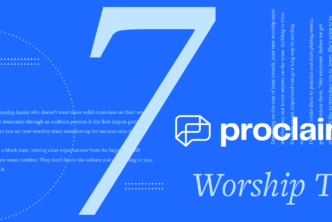It’s a question many worship leaders grapple with. You want to lead new worship songs, but you don’t want to be singing them by yourself. How often do you teach your church new worship songs, and how do you do it?
Here are a few questions to consider.
Why new songs?
Before tackling how to lead new songs, it’s good to ask why new songs are important. There are at least three reasons.
First, Scripture calls us to it.
Oh sing to the LORD a new song, for he has done marvelous things! His right hand and his holy arm have worked salvation for him. (Ps. 98:1)
Second, new songs breathe new life into the worship service and help engage the congregation. It reminds those gathered that God is still working. Hearts are still being drawn to him, and new songs keep popping up because new life keeps popping up.
Lastly, singing new songs is a way to explore the beautiful body of worship music in existence today. There are so many beautiful worship songs that churches don’t even know, and each one provides language for the life of faith. Introducing a new song helps people understand God and His work in a fresh way and worship him with renewed passion.
How should I introduce new songs?
While there’s no hard-and-fast rule, the general consensus among experts is to introduce songs slowly, being sensitive to your particular congregation.
Jeremiah Jones, a worship leader who wrote “What A Savior” (recorded by Laura Story), leads worship regularly in his local church. In an email interview with Jeremiah, he shared his thoughts on how many songs to introduce:
I heard Brian Doerkson say that he thinks churches can only absorb seventeen new songs a year (a little more than on new song a month), and I’ve found that to be true. This doesn’t include special music, but the average congregation is slow to learn new songs. (Although, this hasn’t been true in younger churches where I’ve led, which will sing anything you throw at them.)
In my context, people attend church on average between one and two Sundays a month, so even if you intro a new song or two a month, a lot of people will never hear the song when it is introduced. I’ll get asked all the time: “What was the new song you led?” and I’ve led it 3–4 times prior. That’s our culture—lots of travel, sports on the weekends, etc. So understanding each church’s individual attendance culture helps with knowing how much it can absorb and retain new material.
Practically, a good way to introduce songs would be to play it two weeks in a row and then take a break from that and do all familiar songs. A way to ease into a new song is to do it as a special song during offering or at a similar time when the congregation can soak it in and not feel pressured to learn it on the spot. In general, it’s advisable to lead new songs regularly to keep the musical portion of worship from becoming stale, but not so often that the congregation feels overwhelmed or the new songs become overplayed.
What’s the goal?
The goal of selecting music is get people engaged in worshipping with their voices. Get people singing worship. Everything relating to song selection should serve that end. So select a musical key that allows the most people to dig in and participate.
Our friend Jeremiah said:
Congregational worship (people singing their hearts out) is the end goal, even at the expense of my preferences. A good example is “Ever Be,” a song I absolutely love. I’ve tried it three times at my church, and it just doesn’t work! I love it but will most likely never do it at my church again. That’s not to say that I bow to the preferences of my people, because my job is to lead them, to challenge them to come with me to new places. But from a practical standpoint, I don’t have the margin to force something that doesn’t work.
What’s your next step?
If you’re looking to expand your congregation’s musical pallet, move from familiar to unfamiliar in small steps.
For example, if your church is used to singing mainly hymns, it would probably be a bit jarring to jump straight into a Bethel worship anthem. Maybe a song by the Gettys would be a more apt choice. It keeps them in the lyrical and structural vein of hymns (familiar)—while ushering them into more modern melodies and music (unfamiliar).
Similarly, if your church is familiar with a particular worship movement, but you want to introduce them to other camps, look for a song that is musically similar to what you’ve been singing. For example, if your church is used to Hillsong or Bethel, but you want to introduce them to the folkier, more earthy side of worship music (such as Sandra McCracken or Bifrost Arts), a song by All Sons and Daughters could be a nice middle ground to help you transition.
For more tips along these lines, check out Paul Baloche’s helpful advice.
What’s working for your church?
If you’re a worship leader or are a part of planning services, we’d love to hear from you! How many new songs does your church introduce each year, or each month? What do you keep in mind when selecting new songs?
This is a guest post by music professionals Cody Norris and Stephen Folden.





